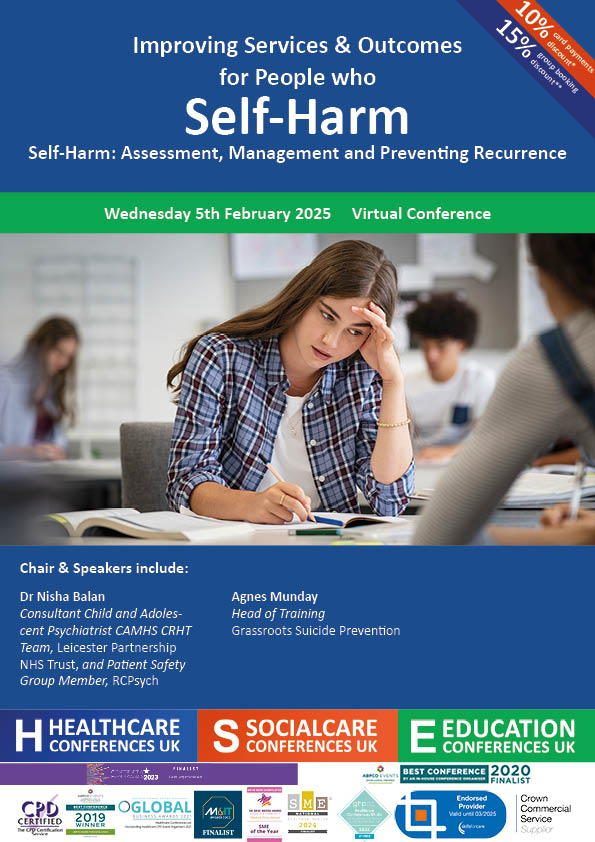Follow the conference on X #SelfHarm
“Worldwide, 10-20% of young people have reported having self-harmed at least once before the age of 18. According to data published in the Mental Health of Children and Young People in England, 2023 Survey, 30.4% of children aged 8 to 16 years with a probable mental health disorder had tried to harm themselves, compared to 4% of children unlikely to have a mental health disorder.”
The Association for Child and Adolescent Mental Health, March 2024
“Self-harm is one of the common reasons for people going to an acute hospital. On and between 1 April 2021 and 31 March 2022, 93,895 people were admitted to hospital as an emergency due to self-harm in England (Office for Health Improvement and Disparities, n.d.). The actual number of people who self-harm will be much greater than this as only a minority will go to hospital.”
Patients at risk of self-harm: continuous observation, Health Services Safety Investigations Body, May 2024
“A recent national study reported that 7.3% of girls aged 11 to 16, and 3.6% of boys aged 11 to 16, had self-harmed or attempted suicide at some point. The figures for 17- to 19-year-olds were 21.5% for girls and 9.7% for boys. Self-harm can occur at any age, but there is evidence that there has been a recent increase in self-harm among young people in England.”
NICE Guideline for Self-harm: assessment, management and preventing recurrence
Recent research shows that there has been a sharp increase in the rate of self-harm, particularly for children and young people.
This conference focuses on improving services and outcomes for people who self-harm, and implementing and monitoring adherence to the NICE Guideline: Self-harm: assessment, management and preventing recurrence. We will also highlight the results and recommendations from the ‘Patients at risk of self-harm: continuous observation’ report by the Health Services Safety Investigations Body.
In this conference, through case studies and expert advice we will explore how we can support people who self-harm by ensuring a compassionate approach, understanding the common causes and drivers, as well as developing safety plans with a path to recovery. With sessions dedicated to those working with children in the education sector, this conference will explore the importance of early identification, how schools can improve their crisis support and the issue of self-harm amongst boys.
This conference will enable you to:
Network with colleagues who are working to improve services and outcomes for people who self-harm
Reflect on the Lived Experience of a person who has self-harmed
Learn from outstanding practice in the management of self-harm
Update your knowledge on national developments including the Sept 2022 National NICE Guideline Self-harm: assessment, management and preventing recurrence
Recognise the benefits of a multi-agency approach to supporting children and young people at risk of self-harmLearn from the ‘Patients at risk of self-harm: continuous observation’ report by the Health Services Safety Investigations Body
Examine what an effective self-harm pathway should look like?
Ensure early identification and intervention in schools
Develop your skills in ensuring a compassionate approach to self-harm
Implementing & Monitoring Adherence to the New NICE Guideline for Self-Harm in Practice: Assessment & Treatment Intervention and Principles
Understand how you can improve the response to self-harm in the emergency department
Identify key strategies for involving and engaging families of people who self-harm
Ensure you are up to date with the latest evidence
Develop strategies to support people to be safe after self-harm
Self assess and reflect on your own practice
Supports CPD professional development and acts as revalidation



